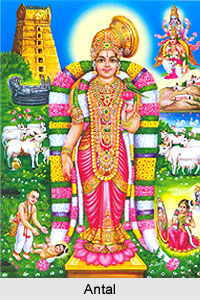 Antal or Andal is the author of devotional Tamil literary work of Nachiar Tirumozhi and Tirupavai, which are recited even at the present age in the season of Margazhi during the winter festival. Antal is the only female among the 12 Alvar saints of Southern India, who is renowned for their association to Vaishnava tradition of Hinduism. Antal is popular for her resolute devotion to the Lord Vishnu, the main deity of the Vaishnava sect. she was born in Srivilliputhoor and the temple there is devoted to her. She was the adopted daughter of Periyalvar, the Alvar poet saint, who found her as a baby. Antal avoided the normal marriage ceremony that was expected from any women of her culture during that period and instead got married to Lord Vishnu, both spiritually and physically. In various parts of Tamil Nadu, Antal is considered more as a form of God than a saint.
Antal or Andal is the author of devotional Tamil literary work of Nachiar Tirumozhi and Tirupavai, which are recited even at the present age in the season of Margazhi during the winter festival. Antal is the only female among the 12 Alvar saints of Southern India, who is renowned for their association to Vaishnava tradition of Hinduism. Antal is popular for her resolute devotion to the Lord Vishnu, the main deity of the Vaishnava sect. she was born in Srivilliputhoor and the temple there is devoted to her. She was the adopted daughter of Periyalvar, the Alvar poet saint, who found her as a baby. Antal avoided the normal marriage ceremony that was expected from any women of her culture during that period and instead got married to Lord Vishnu, both spiritually and physically. In various parts of Tamil Nadu, Antal is considered more as a form of God than a saint.
Early Life of Antal
According to legends, Periyalvar found Antal under a Tulsi plant in the garden of the Srivilliputtur temple. She was originally named as Kodhai and was raised in an ambiance of devotion and love. Periyalvar was extremely fond of her and sang her praises to Lord Vishnu. Her father taught her all tales and philosophies related to the Lord and also taught her Tamil poetry. As Antal grew into a gorgeous maiden, her devotion and love for God increased manifold and she decided to marry Lord Vishnu himself. It is believed, that the Lord appeared to Periyalvar and told him that he accepted all offerings of Kodhai; then Antal`s father understood the divine love that existed the her and Lord Vishnu. It was from then, that Kodhai came to be known as Antal, signifying the girl who ruled over God.
At the age of 15, when her father was preparing to get her married, Antal insisted that she would get married only the Lord at Srirangam. Her father became worried with her decision. As per legends, it is believed that Lord Vishnu once again appeared to Periyalvar and instructed him to send his daughter to Srirangam. It is also said that the Lord appeared the priests at Srirangam in their dreams, and instructed them to prepare for the wedding. Antal went to the sanctum sanctorum of Lord Vishnu and merged with Him completely.
Literary Works of Antal
Antal composed two devotional literary works in the short span of her life of 15 years. Both the works are composed in Tamil verse form and are excellent in their religious, literary, aesthetic and philosophical content. Considering that Antal was merely 15 years old when she wrote the verses, her contribution appears even more extraordinary. Tiruppavai, her initial work, is compilation of 30 verses through which she envisions herself to be a cowherd girl or Gopi during the Lord Krishna incarnation. She desires to serve Krishna and attain happiness not just in her present birth, but in all eternity. She also narrates the religious vows that she, along with her fellow Gopis, will follow for this purpose.
Nachiar Tirumozhi is the second work of Antal, consisting of 143 verses. Nachiar means Goddess and Tirumozhi means Sacred Sayings; so the title signifies Sacred Sayings of the Goddess. The verse expresses her passionate longing for Lord Vishnu, the Divine Beloved. Antal uses intermingling stories from the Sanskrit Puranas and Vedas and classical Tamil poetic conventions to create and unparalleled imagery in the entire Indian religious literature. But as Tirumozhi belongs to an erotic genre of spirituality, it is not propagated by conservative Vaishnavite institutions.
The influence of Antal`s poetic works has been tremendous on the religious life of the people of South India. Tiruppavai is narrated with immense religious fervour by men, women and children, especially in Tamil Nadu. Innumerable scholars have extensively studied both the works, particularly the Thiruppavai and the work has also been translated into several languages.



















